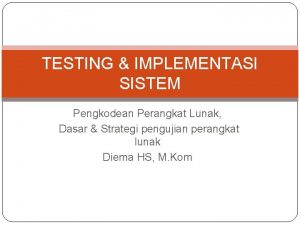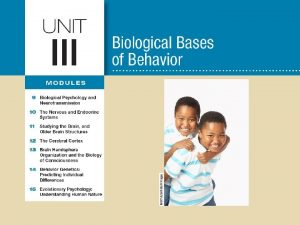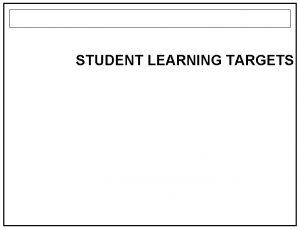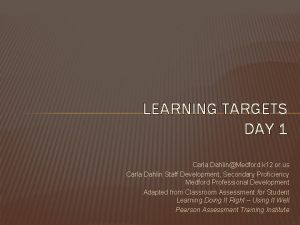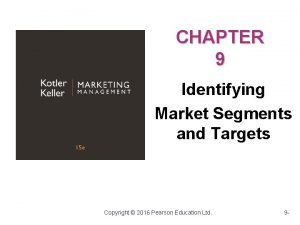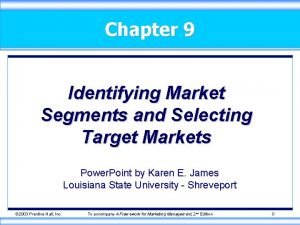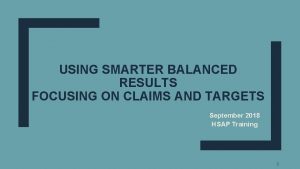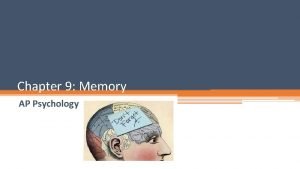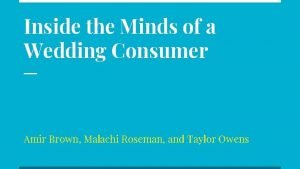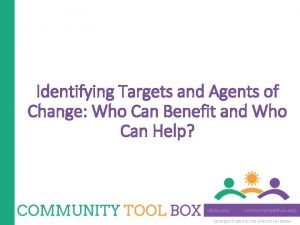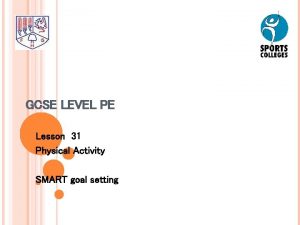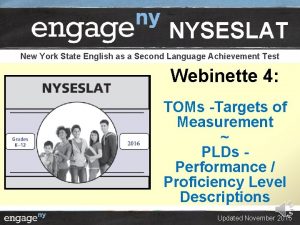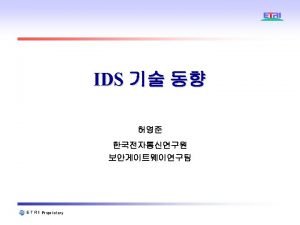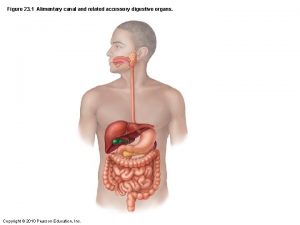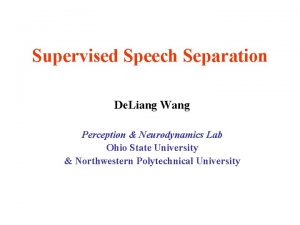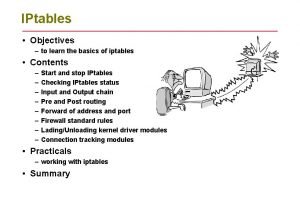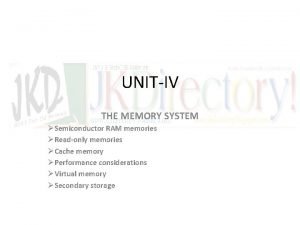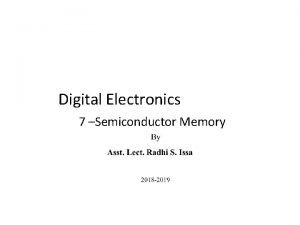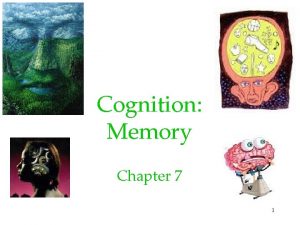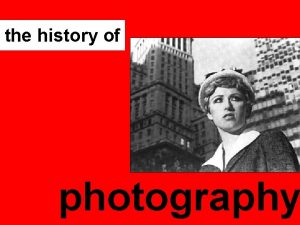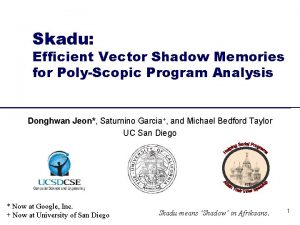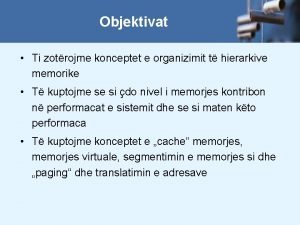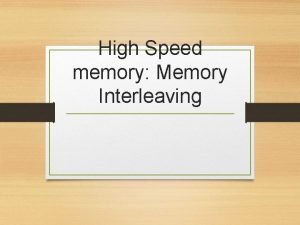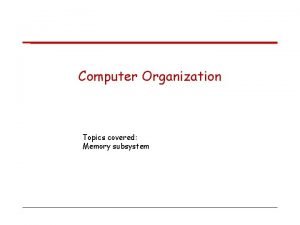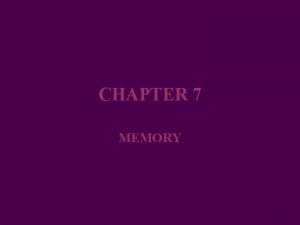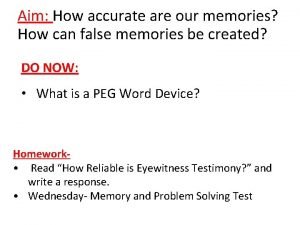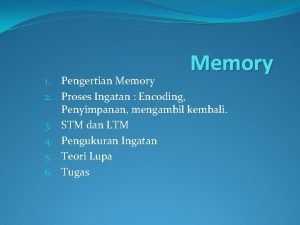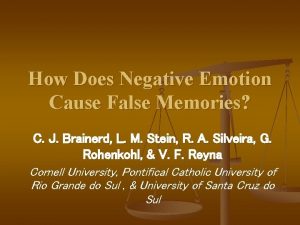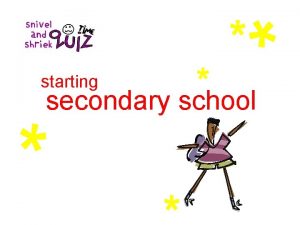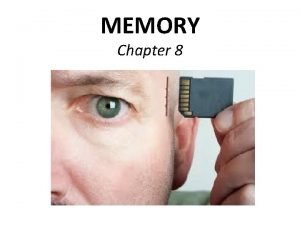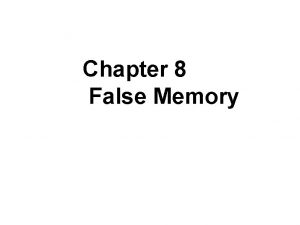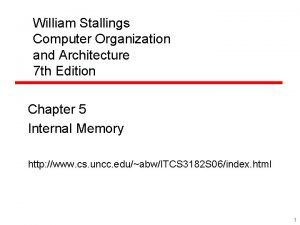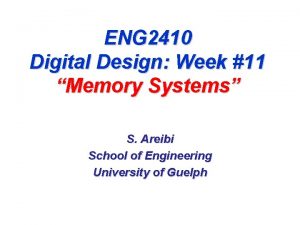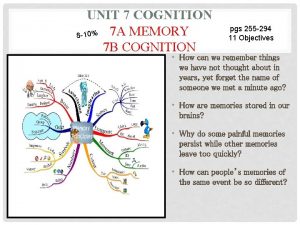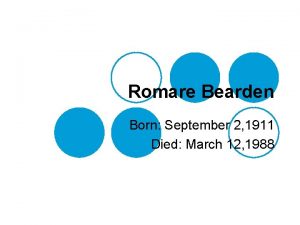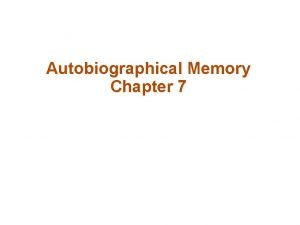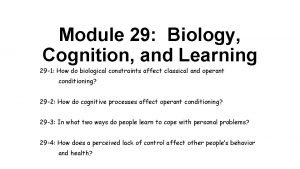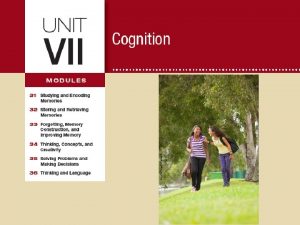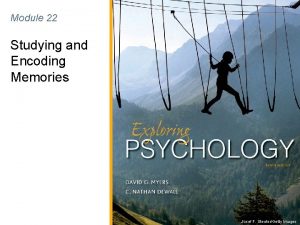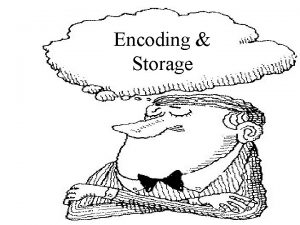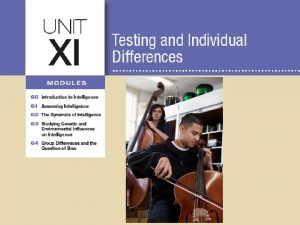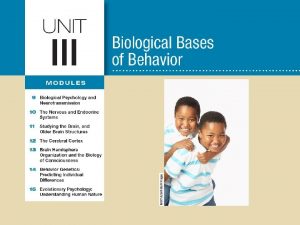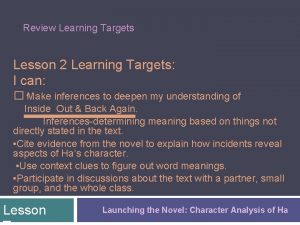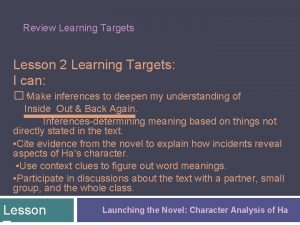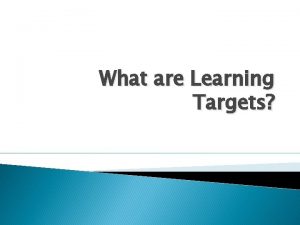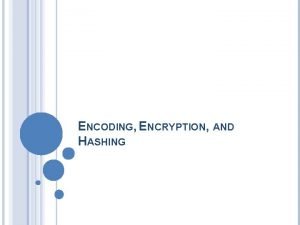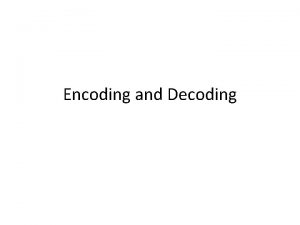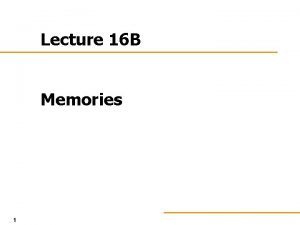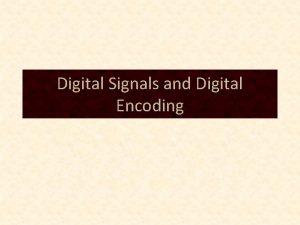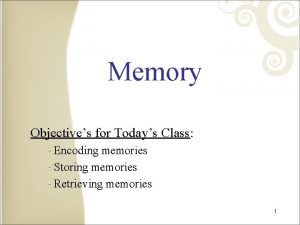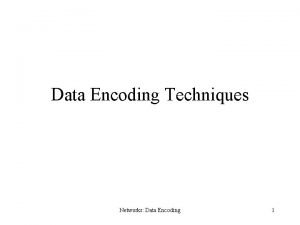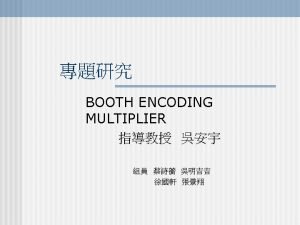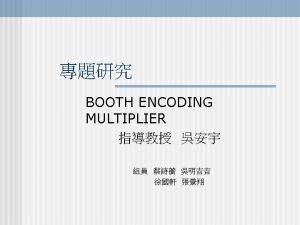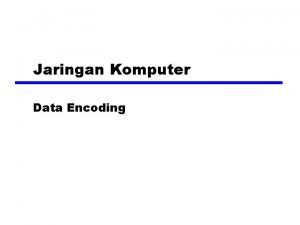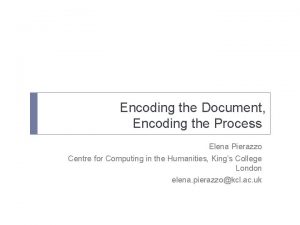Learning Targets Module 31 Studying and Encoding Memories

































































- Slides: 65


Learning Targets Module 31 Studying and Encoding Memories 31 -1 Define memory, and explain how memory is measured. 31 -2 Discuss how psychologists describe the human memory system. 31 -3 Describe the differences between explicit and implicit memories. 31 -4 Discuss the information we process automatically. 31 -5 Explain how sensory memory works. 31 -6 Describe our short-term and working memory capacity. 31 -7 Describe the effortful processing strategies that help us remember new information. 31 -8 Discuss the levels of processing and their effect on encoding.

How is memory defined? the persistence of learning over time through the encoding, storage, and retrieval of information

Research on memory’s extremes has helped us understand how memory works. Some disorders, such as Alzheimer’s disease, slowly strip away memory. At the other extreme are people who would win gold medals in a memory Olympics.

Alzheimer’s disease a progressive neurodegeneration and fatal condition

memory degneration Alzheimer’s disease begins as difficulty remembering new information and progresses into an inability to do everyday tasks. Family members and close friends become strangers; complex speech devolves to simple sentences; the brain’s memory centers weaken and wither. (Desikan et al. , 2009)

What about the other extreme? Russian journalist Solomon Shereshevskii, or ‘S’, had merely to listen while other reporters scribbled notes. ‘S’ could repeat up to 70 digits, if they were read about 3 seconds apart in an otherwise silent room. He could recall digits or words backward as easily as forward.

How is memory measured? recall retrieving information that is not currently in your conscious awareness but that was learned at an earlier time recognition identifying items previously learned relearning something more quickly when you learn it a second or later time

How do we measure memory on tests in school? recall a fill-in-the-blank question, short answer or essay prompt recognition multiple choice or matching relearning studying for a final exam over the entire year’s course content

How do we measure memory in life events? recall telling your friend about the time you won a goldfish at the carnival recognition seeing a brand of cereal on the grocery shelf and recognizing it from the commercial relearning traveling to Costa Rica and pulling back the Spanish you learned in 10 th grade

1. What Would You Answer? Caitlin, a fifth grader, is asked to remember her second- grade teacher’s name. What measure of retention will Caitlin use to answer this question? A. storage B. recognition C. relearning D. recall E. encoding

Rapidly read aloud, eight times over, the following list: JIH, BAZ, FUB, YOX, SUJ, XIR, DAX, LEQ, VUM, PID, KEL, WAV, TUV, ZOF, GEK, HIW. Now look away and try to recall the items.

How did Hermann Ebbinghaus test speed of relearning? Pioneering memory researcher Hermann Ebbinghaus randomly selected a sample of syllables, like those you just saw, practiced them, and tested himself on his ability to accurately recall the items. The day after learning such a list, Ebbinghaus could recall few of the nonsense syllables. But they weren’t entirely forgotten.

What were Hermann Ebbinghaus’ findings? Ebbinghaus found that the more times he practiced a list of nonsense syllables on Day 1, the less time he required to relearn it on Day 2. Speed of relearning is one measure of memory retention. (From Baddeley, 1982. )

How do psychologists describe the human memory system? Psychologists propose an information-processing model which likens human memory to computer operations. To remember any event, we must… Encode (put in) the new information… store (organize) the information…. retrieve (pull out) the information.

What is parallel processing? considering many aspects of a problem simultaneously; the brain’s natural mode of information processing for many functions

How does parallel processing function? Recall from Module 18 that when a person sees an object, they don't see just one thing, but rather many specific aspects that combined, allow the person to identify the object in its entirety.

What did early models of memory formation look like? Richard Atkinson and Richard Shiffrin proposed a three-stage model of memory. sensory memory: the immediate, very brief recording of sensory information in the memory system. short-term memory: memory that holds a few items briefly before the information is stored or forgotten. long-term memory: relatively permanent and limitless storehouse of the memory system.

How have early models been modified? Today’s researchers recognize other ways long-term memories form. For example, some information slips into long-term memory via a “back door, ” without our consciously attending to it (automatic processing). So much active processing occurs in the short-term memory stage that many now prefer the term working memory.

What is working memory? a newer understanding of short-term memory that adds conscious, active processing of incoming auditory and visual information, and of information retrieved from long-term memory

How does Baddeley’s model address working memory? Alan Baddeley’s (2002) model of working memory, includes visual-spatial and auditory rehearsal of new information. A hypothetical central executive (manager) focuses our attention, and pulls information from longterm memory to help make sense of new information.

What is the role of the central executive? Baddeley’s idea of a central executive is key to the new model. The central executive coordinates focused processing without which, information often fades.

What are explicit and implicit memories? explicit memory implicit memory retention of facts and experiences from longterm memory that one can consciously know and “declare” retention of learned skills or classically conditioned associations in long-term memory independent of conscious recollection (Also called declarative memory. ) (Also called nondeclarative memory. )

How do explicit and implicit memories differ? explicit memory implicit memory We encode explicit memories through conscious effortful processing; encoding that requires attention and conscious effort. Automatic processing is unconscious encoding of incidental information, such as space, time, and frequency, and of welllearned information, such as word meanings.

What information do we process automatically? space Can you remember the page or side of the book certain charts, graphs or material is located? time Have you ever retraced your steps through the sequence of your day to find a lost item? frequency Can you recall how many times today you have run into a good friend?

Look at these letters for one second.

What was George Sperling’s sensory memory experiment? When George Sperling (1960) flashed a group of letters similar to this for 1/20 th of a second, people could recall only about half the letters. But when signaled to recall a particular row immediately after the letters had disappeared, they could do so with near-perfect accuracy.

What is iconic memory? Sperling’s sensory memory experiment demonstrated iconic memory, a fleeting sensory memory of visual stimuli. For a few tenths of a second, our eyes register a picture-image memory of a scene, and we can recall any part of it in amazing detail.

What is echoic memory? We also have an impeccable, though fleeting, sensory memory for auditory stimuli, called echoic memory (Cowan, 1988; Lu et al. , 1992). Picture yourself in class, as your attention drifts to thoughts of the weekend. If your mildly irked teacher tests you by asking, “What did I just say? ” you can recover the last few words from your mind’s echo chamber. Auditory echoes tend to linger for 3 or 4 seconds.

How are short-term and working memory related? Recall that short-term memory refers to what we can briefly retain. The related idea of working memory also includes our active processing, as our brain makes sense of incoming information and links it with stored memories. What are the limits of what we can hold in this middle, short-term stage?

What is our short-term memory capacity? George Miller (1956) proposed that we can store somewhere between 5 and 9 pieces of information (often referred to as 7 +/- 2) in short-term memory. Other researchers have confirmed that we can, if nothing distracts us, recall about seven digits. But the number varies by task; we tend to remember about six letters and only about five words. (Baddeley et al. , 1975; Cowan, 2015)

How fast do short-term memories disappear? Psychologists Peterson and Peterson asked subjects to remember three-consonant groups, such as CHJ. Without rehearsal, after 3 seconds, people recalled the letters only about half the time; after 12 seconds, they seldom recalled them at all.

What is our working memory capacity? Working memory capacity varies, depending on age and other factors. Compared with children and older adults, young adults have a greater working memory capacity.

What is the benefit of a large working memory capacity? Having a large working memory capacity—the ability to juggle multiple items while processing information—tends to aid information retention after sleeping and creative problem solving. (De Dreu et al. , 2012; Fenn & Hambrick, 2012; Wiley & Jarosz, 2012)

What are some effortful processing strategies that can help us encode and retrieve? chunking mnemonics hierarchies Several effortful processing strategies can boost our ability to form new memories. Later, when we try to retrieve a memory, these strategies can make the difference between success and failure.

Look at the letters and numbers below for one minute. Then look away and try to recall as many as you can. FBICIADEAFEMAIRS 1861186519141918

Would it be any easier to memorize now? FBI CIA 1861 DEA 1865 FEMA 1914 IRS 1918

What is chunking? Chunking is organizing items into familiar, manageable units. 16 items would be too much for the STM to hold, but chunked into 5 meaningful items, fits the 7 +/- 2 capacity of short-term memory. Were you able to recall the letters easier when chunked or grouped in the second way?

Do you know these acronyms and acrostics? HOMES My Very Energetic Mother Just Served Up Nine Pancakes ROYGBIV

What is a mnemonic device? memory aids, especially those techniques that use vivid imagery and organizational devices, like acronyms or acrostics We more easily remember concrete, visualizable words (like bicycle or book) than we do abstract words (like peace or love).

What is the peg-word system The peg-word system is a mnemonic device that utilizes visual imagery and this simple jingle. First, memorize the peg-word pairs on the right. One – bun Two – shoe Three-tree Four-door Five-bee hive Six – sticks Seven – heaven Eight – gate Nine – swine Ten - hen

How does the peg-word system work? Next visually associate the peg-words with to-beremembered items. Close your eyes and see the image you create. Really focus on it. Now let’s try a short grocery list to remember: Carrots? Stick them into the imaginary bun. See it? Milk? Fill the shoe with it. See it? Paper towels? Lay them over the tree branch. See it? Think bun, shoe, tree and you see their associated images: carrots, milk, paper towels.

Try the peg-word technique to memorize the characteristics of the four stages of sleep from Module 23. One – bun Two – shoe Three-tree Four-door NREM-1: hypnogogic sensations and hallucinations NREM-2: sleep spindles NREM-3: delta waves, hard to awaken REM: rapid eye movement, dreams, muscle paralysis

How do hierarchies aid retrieval? When we organize words or concepts into hierarchical groups, as illustrated here with some of the concepts from this section, we remember them better than when we see them presented randomly.

How would you use hierarchies to group this list of grocery items? Carrots, yogurt, pretzels, orange juice, bananas, milk, eggs, oranges, beans, chicken, bacon, cheese, crackers, popcorn, red peppers, sour cream. Categorizing items into hierarchies increases recall.

How would you use hierarchies to group this list of grocery items? Cont. Did you make categories such as: PRODUCE: carrots, oranges, beans, red peppers, bananas DAIRY: milk, eggs, sour cream, yogurt, cheese MEAT: bacon, chicken produce SNACKS: pretzels, crackers, popcorn Where did you place ‘orange juice’?

How would you use hierarchies to group the information on memory in this Unit? long-term memory, short-term memory, working memory, sensory memory, explicit and implicit memory, iconic and echoic imagery Categorizing items into hierarchies increases recall.

How can the spacing effect impact memory retrieval? The spacing effect is the tendency for distributed study or practice to yield better long-term retention than is achieved through massed study or practice. Massed practice (cramming) can produce speedy short-term learning and a feeling of confidence. But to paraphrase Ebbinghaus (1885), those who learn quickly also forget quickly. Distributed practice produces better long-term recall.

How can the testing effect impact memory retrieval? One effective way to distribute practice is repeated self-testing, a phenomenon that researchers Roediger and Jeffrey Karpicke (2006) have called the testing effect. Testing does more than assess learning and memory: it improves them. (Brown et al. , 2014; Pan et al. , 2015; Trumbo et al. , 2016)

What is the best strategy for learning? “Two techniques that students frequently report using for studying— highlighting (or underlining) text and rereading text—[have been found] ineffective. ” Happily, “retrieval practice (or testing) is a powerful and general strategy for learning. ” Roediger (2013)

What are two levels of processing? Shallow processing Deep processing encoding on a basic level, based on the structure or appearance of words encoding semantically, based on the meaning of the words; tends to yield the best retention

Rapidly answer the following questions: Fergus Craik and Endel Tulving’s work on processing levels showed the deeper, semantic processing triggered by the third question yielded better recall than did the shallower processing elicited by the second or first question.

2. What Would You Answer? Which of the following is most likely to lead to semantic encoding of a list of words? A. thinking about how the words relate to your own life B. practicing the words for a single extended period C. breaking up the practice into several relatively short sessions D. noticing where in a sentence the words appear E. focusing on the number of vowels and consonants in the words

AP® Exam Tip Are you often pressed for time? The most effective way to cut down on the amount of time you need to spend studying is to increase the meaningfulness of the material. If you can relate the material to your own life—and that’s pretty easy when you’re studying psychology—it takes less time to master it. Use this tip while studying for the AP® exam.

Why should I make material meaningful? From his experiments on himself, Ebbinghaus estimated that, compared with learning nonsense syllables, learning meaningful material required 1/10 th the effort. As memory researcher Wayne Wickelgren noted, “The time you spend thinking about material you are reading and relating it to previously stored material is about the most useful thing you can do in learning any new subject matter. ”

What is the self-reference effect? Most people excel at remembering personally relevant information. Asked how well certain adjectives describe someone else, we often forget them; asked how well the adjectives describe us, we often remember them. This tendency, called the self-reference effect, is especially strong in members of individualist Western cultures. (Symons & Johnson, 1997; Wagar & Cohen, 2003)

Learning Target 31 -1 Review Define memory, and explain how memory is measured. § Memory is learning that has persisted over time, through the storage and retrieval of information. § Evidence of memory may be seen in an ability to recall information, recognize it, or relearn it more easily on a later attempt.

Learning Target 31 -2 Review Discuss how psychologists describe the human memory system. § Psychologists use memory models to think and communicate about memory. § Information-processing models involve three processes: encoding, storage, and retrieval. § Through parallel processing, the human brain processes many things simultaneously. § The connectionism information-processing model views memories as products of interconnected neural networks.

Learning Target 31 -2 Review cont. Discuss how psychologists describe the human memory system. § The three processing stages in the Atkinson-Shiffrin model are sensory memory, short-term memory, and long-term memory. More recent research has updated this model to include two important concepts: (1) working memory, to stress the active processing occurring in the second memory stage; and (2) automatic processing, to address the processing of information outside of conscious awareness.

Learning Target 31 -3 Review Describe the differences between long-term explicit and implicit memories. § Explicit (declarative) memories—our conscious memories of facts and experiences—develop with effortful processing, which requires conscious effort and attention. § Implicit (nondeclarative) memories—of skills and classically conditioned associations—happen without our awareness, through automatic processing.

Learning Target 31 -4 Review Discuss the information we process automatically. § In addition to skills and classically conditioned associations, we automatically process incidental information about space, time, and frequency.

Learning Target 31 -5 Review Explain how sensory memory works. § Sensory memory feeds iconic and echoic information into working memory for active processing. § An iconic memory is a very brief sensory memory of visual stimuli; an echoic memory is a three- or four-second sensory memory of auditory stimuli.

Learning Target 31 -6 Review Describe our short-term and working memory capacity. § Short-term memory capacity is about seven items, plus or minus two, but this information disappears from memory quickly without rehearsal. § Working memory capacity varies, depending on age, intelligence level, and other factors.

Learning Target 31 -7 Review Describe the effortful processing strategies that help us remember new information. § Effective effortful processing strategies include chunking, mnemonics, hierarchies, and distributed practice sessions (which produce results due to the spacing effect). § The testing effect is the finding that consciously retrieving, rather than simply rereading, information enhances memory.

Learning Target 31 -8 Review Discuss the levels of processing and their effect on encoding. § Depth of processing affects long-term retention. § In shallow processing, we encode words based on their structure, appearance, or sound. § Retention is best when we use deep processing, encoding words based on their meaning. § We also more easily remember material that is personally meaningful—the self-reference effect.
 Hardware encoding or software encoding
Hardware encoding or software encoding Module 11 studying the brain
Module 11 studying the brain Writing learning targets
Writing learning targets Agonist antagonist muscles
Agonist antagonist muscles Willingham fire
Willingham fire Product learning target example
Product learning target example Learning targets knowledge, reasoning, skill product
Learning targets knowledge, reasoning, skill product Learning targets helping students aim for understanding
Learning targets helping students aim for understanding Objective of warehouse management system
Objective of warehouse management system Identifying market segments and targets chapter 9
Identifying market segments and targets chapter 9 Identifying market segments and targets chapter 9
Identifying market segments and targets chapter 9 Identifying market segments and targets chapter 9
Identifying market segments and targets chapter 9 Identifying market segments and targets
Identifying market segments and targets Identifying market segments and targets
Identifying market segments and targets Pituitary hormones and their targets
Pituitary hormones and their targets Smarter balanced claims and targets
Smarter balanced claims and targets Single segment concentration
Single segment concentration Source memory
Source memory Cuadro comparativo e-learning y b-learning
Cuadro comparativo e-learning y b-learning C device module module 1
C device module module 1 Racial etiquette targets
Racial etiquette targets Brides magazine targets consumers who are in
Brides magazine targets consumers who are in Targets of change
Targets of change What does smart stand for in pe
What does smart stand for in pe Nyseslat levels
Nyseslat levels The process of customer-driven marketing involves
The process of customer-driven marketing involves Attainment targets barbados
Attainment targets barbados Physical targets
Physical targets Djids
Djids Peristalsis and segmentation
Peristalsis and segmentation Tonnie de koster
Tonnie de koster Europe 2020 targets
Europe 2020 targets On training targets for supervised speech separation
On training targets for supervised speech separation Iptables command
Iptables command Semiconductor ram memories
Semiconductor ram memories The plot of the giver
The plot of the giver Take out a piece of paper
Take out a piece of paper Irvine valley memories
Irvine valley memories Semiconductor ram memories
Semiconductor ram memories Implicit explicit memory
Implicit explicit memory Calamba cradle of a genius
Calamba cradle of a genius How to preserve personal memories
How to preserve personal memories Clever hcpa
Clever hcpa Hierarkia e memories
Hierarkia e memories What is memory interleaving
What is memory interleaving The bones of mammals not alike
The bones of mammals not alike Semiconductor ram memories in computer organization
Semiconductor ram memories in computer organization Difference between proactive and retroactive interference
Difference between proactive and retroactive interference How accurate are our memories
How accurate are our memories Perbedaan memories dan memory
Perbedaan memories dan memory How does negative emotion cause false memories
How does negative emotion cause false memories I like school poem by lenore hetrick
I like school poem by lenore hetrick Secondary school memories
Secondary school memories Teams login
Teams login Memories definition
Memories definition False memories chapter 8
False memories chapter 8 Poem for leavers year 6
Poem for leavers year 6 Semiconductor ram memories in computer organization
Semiconductor ram memories in computer organization Memories (2013)
Memories (2013) Semiconductor ram memories in computer organization
Semiconductor ram memories in computer organization What effortful processing methods aid in forming memories?
What effortful processing methods aid in forming memories? Romare bearden born
Romare bearden born Memories factory
Memories factory Flashbulb memory
Flashbulb memory Learning: module 26: magnetic forces and fields
Learning: module 26: magnetic forces and fields Module 29 biology cognition and learning
Module 29 biology cognition and learning
